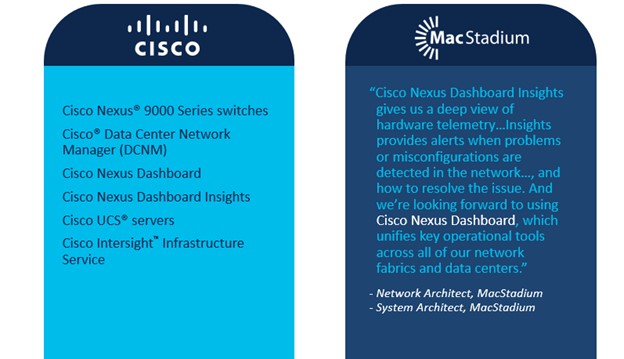- I recommend the Pixel 9 to most people looking to upgrade - especially while it's $250 off
- Google's viral research assistant just got its own app - here's how it can help you
- Sony will give you a free 55-inch 4K TV right now - but this is the last day to qualify
- I've used virtually every Linux distro, but this one has a fresh perspective
- The 7 gadgets I never travel without (and why they make such a big difference)
MacStadium Makes a Leap Toward Data Center Automation with Cisco Nexus Dashboard – Cisco Blogs

At the highest levels, data center networking strategies are built on three main pillars: connect, secure, and automate.
While connectivity and security are obvious, mandatory table stakes, automation has historically been less compulsory and more opportunistic. But, for a number of reasons, that’s changing in rapid and impactful ways. Increasingly, our customers must understand the state of their network at any given time to deliver consistent and high-quality network services. They must readily adapt to new requirements. And they are looking to enable application agility and adopt cloud operational models for handling the growing scale and complexity of their infrastructure.
As a result, automation is no longer an elective luxury. In fact, it has become an important enabler of connectivity, security, and visibility, and it acts as the glue that brings together multiple operating domains, including NetOps, SecOps, CloudOps, and DevOps.
An Intent-Based Networking approach with advanced analytics and automation deliver on all of these core network requirements.
Three Essential Elements for Automation
It’s important to note that automation doesn’t happen overnight, and every organization is at a different stage with their infrastructure and applications. Some companies still have monolithic apps running on legacy systems, while others are deeply entrenched in cloud-based DevOps, microservices, and container-driven deployments.
No matter where you are on your automation journey, there are three essential elements to consider:
- Programmable infrastructure: You need modern infrastructure solutions that support programmability and open APIs.
- Infrastructure as Code (IaC): IaC enables IT operations teams to embrace a DevOps model that accelerates application deployment, improves infrastructure monitoring, optimizes network performance, and ensures compliance in a secure, predictable manner.
- Infrastructure simplicity: You need solutions that reduce complexity and enable you to be agile and proactive in addressing operational needs across data center and cloud environments.
The growing need for automation is what drove us to build Cisco Nexus Dashboard. The intuitive platform provides services such as Insights and Orchestrator, and a single operational view of your geographically dispersed infrastructure and multicloud environments. The platform accelerates NetOps and DevOps capabilities. And it aligns seamlessly with third-party ecosystem tools from Terraform, ServiceNow, and Splunk, with other integrations to come.
MacStadium, one of the leading providers of private cloud solutions built on Apple infrastructure, is already taking advantage of the new platform. Their Orchestration with Kubernetes on Apple (Orka) offering is the only virtualization layer for Mac infrastructure based on Docker and Kubernetes technology.
MacStadium has adopted a variety of Cisco solutions to:
- Align infrastructure across multiple data centers
- Boost operational efficiency and speed
- Increase data center automation and insights
Leveraging software-defined infrastructure and unified tooling, MacStadium has simplified its data center operations and improved infrastructure visibility and assurance across multiple sites.

Instead of disparate tools and customized scripts, MacStadium now has a singular management platform. It has the ability to automate and quickly scale its infrastructure to meet new customer demand, without adding more specialists. More efficient and automated IT operations have had a positive impact on service availability, mean time to repair (MTTR), and the company’s bottom line. And MacStadium has established multisite connectivity, enabled visibility and assurance, improved infrastructure management, and accelerated data center deployments.
To learn more, read the full MacStadium case study. And don’t hesitate to contact us or our partners as you seek to extend network automation beyond your data center.
Additional resources
Share:

